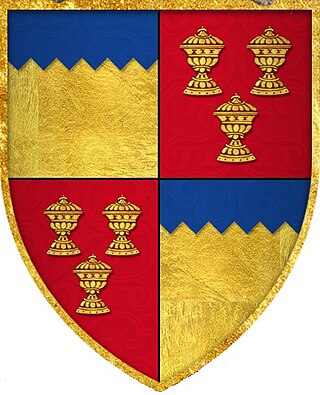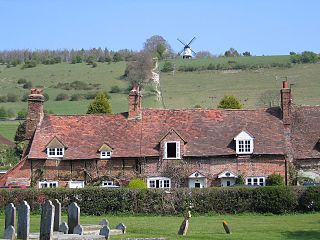Related Research Articles

Thomas Arundel was an English clergyman who served as Lord Chancellor and Archbishop of York during the reign of Richard II, as well as Archbishop of Canterbury in 1397 and from 1399 until his death, an outspoken opponent of the Lollards. He was instrumental in the usurpation of Richard by his cousin Henry Bolingbroke, who became Henry IV.
The Lord High Chancellor of Ireland was the highest judicial office in Ireland until the establishment of the Irish Free State in 1922. From 1721 to the end of 1800, it was also the highest political office of the Irish Parliament: the Chancellor was Speaker of the Irish House of Lords. The Lord Chancellor was also Lord Keeper of the Great Seal of Ireland. In all three respects, the office mirrored the Lord High Chancellor of Great Britain.

Piers Butler, 8th Earl of Ormond, 1st Earl of Ossory also known as Red Piers, was from the Polestown branch of the Butler family of Ireland. In the succession crisis at the death of Thomas Butler, 7th Earl of Ormond he succeeded to the earldom as heir male, but lost the title in 1528 to Thomas Boleyn. He regained it after Boleyn's death in 1538.

The Dean of St Patrick's Cathedral is the senior cleric of the Protestant St Patrick's Cathedral, Dublin, elected by the chapter of the cathedral. The office was created in 1219 or 1220, by one of several charters granted to the cathedral by Archbishop Henry de Loundres between 1218 and 1220.
Robert Waldby was a native of York and friar of the Order of Saint Augustine who followed Edward, the Black Prince into Aquitaine, and undertook a number of diplomatic missions on his behalf. After studying at Toulouse, he became professor of theology there. He later became close to Edward's son, King Richard II. He was a firm opponent of John Wycliffe, wrote a book denouncing him, and was a member of the Synod which assembled at Oxford in 1382 to judge his orthodoxy.
James Butler, 3rd Earl of Ormond, was a noble in the Peerage of Ireland. He acceded to the title in 1382, and built Gowran Castle three years later in 1385 close to the centre of Gowran, making it his usual residence, whence his common epithet, The Earl of Gowran.

The Diocese of Ossory is a Latin Church diocese of the Catholic Church in eastern Ireland. It is one of three suffragan dioceses in the ecclesiastical province of the Metropolitan Archbishop of Dublin. Currently, it is led by Niall Coll who was appointed on 28 October 2022 and will be ordained bishop on 22 January 2023.
Robert Fowler was an Anglo-Irish clergyman. He served as the Archbishop of Dublin in the Church of Ireland from 1779 until his death in 1801.

Geoffrey de Turville or de Tourville was an English-born judge and cleric in thirteenth-century Ireland, who held office as Bishop of Ossory and Lord Chancellor of Ireland, and was noted as an extremely efficient administrator. His career has been described as an excellent example of what a clerk in the royal service in that era might hope to accomplish.

Alexander de Balscot, also known as Alexander Petit was one of the leading Irish clerics and statesmen of the late fourteenth century, who held the offices of Bishop of Ossory, Bishop of Meath, Treasurer of Ireland and Lord Chancellor of Ireland.
William Tany or Tani was Prior of the Order of Hospitallers in Ireland; he also served as Justiciar of Ireland 1373-1374, and as Lord Chancellor of Ireland from 1374 to 1377, and again from 1382 to 1384.
John de St Paul, also known as John de St. Pol, John de Owston and John de Ouston, was an English-born cleric and judge of the fourteenth century. He was Archbishop of Dublin 1349–62 and Lord Chancellor of Ireland 1350–56. He had previously been Master of the Rolls in England 1337–40. Apart from a brief period of disgrace in 1340, he enjoyed the confidence of King Edward III. He was described as a zealous supporter of English rule in Ireland, but also as a pragmatic statesman who was willing to conciliate the Anglo-Irish ruling class. He did much to enlarge and beautify Christ Church, Dublin, although virtually no trace of his improvements survive, as they were destroyed by the Victorian rebuilding of the cathedral.

Thomas de Everdon was an English-born cleric and judge, who was a trusted Crown official in Ireland for several decades.
Thomas Minot, also spelt Mynot or Mynyot was an English-born judge and cleric in fourteenth-century Ireland. He was Archbishop of Dublin from 1363 to 1375. He is chiefly remembered for his extensive restoration works to St Patrick's Cathedral, Dublin, and in particular for rebuilding the Cathedral's tower, which is still called Minot's Tower.
Robert le Poer was an Irish judge and Crown official who held the offices of Lord High Treasurer of Ireland and Chief Baron of the Irish Exchequer.
Robert Preston, 1st Baron Gormanston was an Anglo-Irish nobleman, statesman and judge of the fourteenth century. He held several senior judicial offices including, for a brief period, that of Lord Chancellor of Ireland. He was the founder of the leading Anglo-Irish Preston family whose titles included Viscount Gormanston and Viscount Tara.
Peter Rowe was an Irish judge who held the office of Lord Chief Justice of Ireland intermittently between 1388 and 1397.
Richard de Ledrede, also known as Richard Ledred, was a 14th-century churchman in Ireland who served as Bishop of Ossory. His long tenure as Bishop was marked by bitter controversies and repeated quarrels with his colleagues, both lay and clerical.
William de Bromley was a 14th-century dignitary and Crown official in Ireland.
Walter FitzWilliam Cotterell was an Irish barrister and Crown official of the late fourteenth century. He was Serjeant-at-law (Ireland) and acted from time to time as a judge of gaol delivery and of assize, although he was never a justice in the Royal Courts. The evidence suggests that he was a conscientious and hard-working official who enjoyed the complete trust of the English Crown.
References
- 1 2 3 4 5 6 7 8 9 Little, Andrew George "Richard Northalis" Dictionary of National Biography 1885-1900 Vol. 41 p.183
- ↑ Beresford, David "Northalis, Richard" Cambridge Dictionary of Irish Biography
- 1 2 D'Alton, John Memoirs of the Archbishops of Dublin Hodges and Smith Dublin 1838 p.150
- ↑ Patent Roll 15 Richard II
- 1 2 Ball, F. Elrington The Judges in Ireland 1221–1921 John Murray London 1926